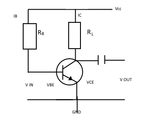Resistanceisfutile
Member level 4

- Joined
- Aug 22, 2012
- Messages
- 77
- Helped
- 2
- Reputation
- 4
- Reaction score
- 1
- Trophy points
- 1,288
- Activity points
- 2,008

Ok so I have a really simple Common Emitter amplifier (I know it's not a very reliable circuit, but please ignore that).
I'm a little confused as to how I select the base current.
I have the equations: Vcc=IB*RB +VBE
and VCC=IC*RL + VCE
The component values are select so that IB makes VCE half the power supply voltage.
This is probably really simple, but can anyone help me out here? I'm confused as to how I select the right values.
Oh yeah, and the transistor VBE=0.6v, and hFE = 100

